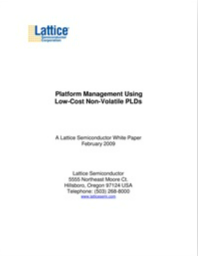Platform Management Using Low-Cost Non-Volatile PLDs
Power-up control, general purpose I/O expansion, voltage level translation and interface bridging are common functions in telecom infrastructure, server and industrial applications. System designers are turning to the use of programmable logic devices (PLDs) to implement these functions in their designs due to the inherent time-to-market and design flexibility advantages they offer over ASICs and ASSPs.
By using PLDs in their designs, designers can respond to changing market standards and requirements within a compressed window of opportunity.
Download this whitepaper to find out more.
Read More
By submitting this form you agree to Lattice Semiconductor Corporation contacting you with marketing-related emails or by telephone. You may unsubscribe at any time. Lattice Semiconductor Corporation web sites and communications are subject to their Privacy Notice.
By requesting this resource you agree to our terms of use. All data is protected by our Privacy Notice. If you have any further questions please email dataprotection@techpublishhub.com
Related Categories: Automotive, Communication, Components, Embedded, Industrial, Power, Switches

More resources from Lattice Semiconductor Corporation
Implementing Flexible USB Type-C Control Using FPGA Technology
Type-C interfaces bring dramatic benefits to consumers. However, in order to realize this potential designers must implement Type-C's Power Deliver...
THE IMPACT OF ENERGY EFFICIENCY STANDARDS ON STANDBY POWER IN CONSUMER ELECTRONICS DESIGN
As more strict government regulations regarding power consumption appear, even traditional home and office appliances like LCD TVs, set top boxes (...
An FPGA Approach to Implementing Time-Critical Functions in Multi-Sensor Mobile Designs
Today's massive smartphone market is often depicted as a hotbed of innovation for the continual advancement of cost-effective, power efficient solu...
